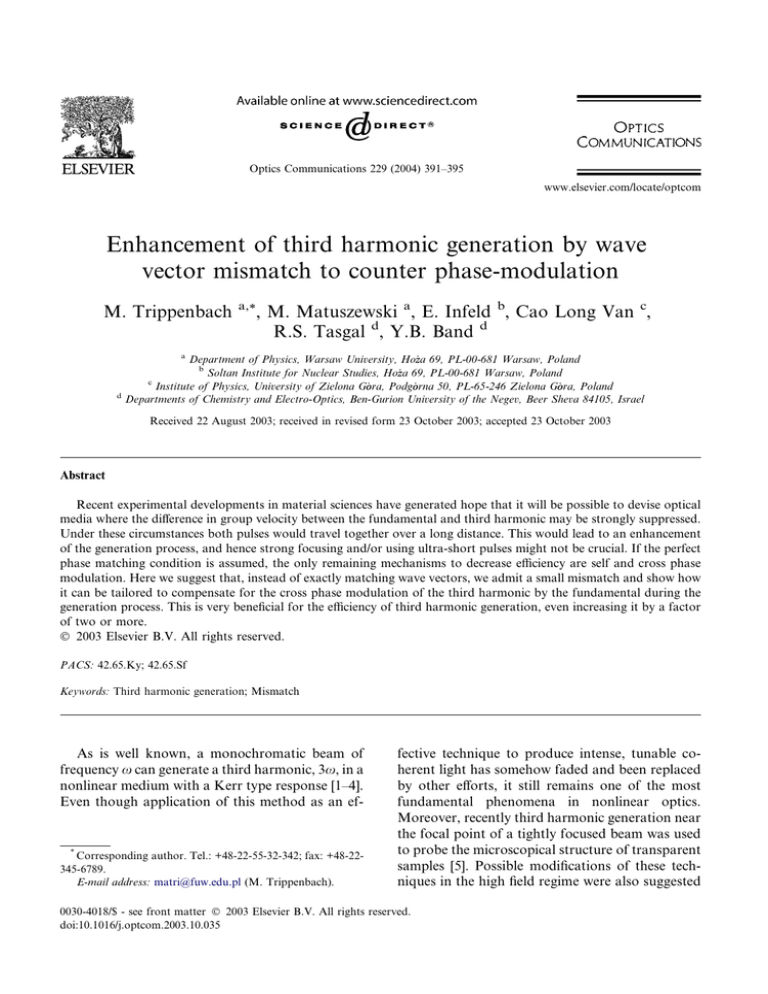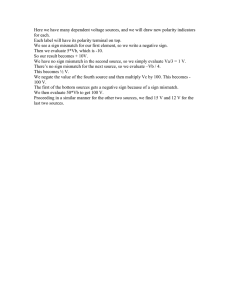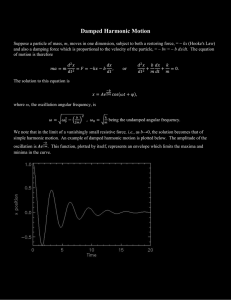
Optics Communications 229 (2004) 391–395
www.elsevier.com/locate/optcom
Enhancement of third harmonic generation by wave
vector mismatch to counter phase-modulation
M. Trippenbach
a,*
, M. Matuszewski a, E. Infeld b, Cao Long Van c,
R.S. Tasgal d, Y.B. Band d
a
d
Department of Physics, Warsaw University, Ho_za 69, PL-00-681 Warsaw, Poland
b
Soltan Institute for Nuclear Studies, Ho_za 69, PL-00-681 Warsaw, Poland
c
Institute of Physics, University of Zielona Go_ ra, Podgo_ rna 50, PL-65-246 Zielona Go_ ra, Poland
Departments of Chemistry and Electro-Optics, Ben-Gurion University of the Negev, Beer Sheva 84105, Israel
Received 22 August 2003; received in revised form 23 October 2003; accepted 23 October 2003
Abstract
Recent experimental developments in material sciences have generated hope that it will be possible to devise optical
media where the difference in group velocity between the fundamental and third harmonic may be strongly suppressed.
Under these circumstances both pulses would travel together over a long distance. This would lead to an enhancement
of the generation process, and hence strong focusing and/or using ultra-short pulses might not be crucial. If the perfect
phase matching condition is assumed, the only remaining mechanisms to decrease efficiency are self and cross phase
modulation. Here we suggest that, instead of exactly matching wave vectors, we admit a small mismatch and show how
it can be tailored to compensate for the cross phase modulation of the third harmonic by the fundamental during the
generation process. This is very beneficial for the efficiency of third harmonic generation, even increasing it by a factor
of two or more.
Ó 2003 Elsevier B.V. All rights reserved.
PACS: 42.65.Ky; 42.65.Sf
Keywords: Third harmonic generation; Mismatch
As is well known, a monochromatic beam of
frequency x can generate a third harmonic, 3x, in a
nonlinear medium with a Kerr type response [1–4].
Even though application of this method as an ef-
*
Corresponding author. Tel.: +48-22-55-32-342; fax: +48-22345-6789.
E-mail address: matri@fuw.edu.pl (M. Trippenbach).
fective technique to produce intense, tunable coherent light has somehow faded and been replaced
by other efforts, it still remains one of the most
fundamental phenomena in nonlinear optics.
Moreover, recently third harmonic generation near
the focal point of a tightly focused beam was used
to probe the microscopical structure of transparent
samples [5]. Possible modifications of these techniques in the high field regime were also suggested
0030-4018/$ - see front matter Ó 2003 Elsevier B.V. All rights reserved.
doi:10.1016/j.optcom.2003.10.035
392
M. Trippenbach et al. / Optics Communications 229 (2004) 391–395
[6]. As was mentioned in [6,7], at higher intensities
self and cross-phase modulation and even higher
order effects can no longer be neglected in the description of the dynamics [8]. The role of the mismatch was mentioned in this context.
The efficiency of harmonic generation in ultrashort lasers is limited by the phase mismatch and
temporal walk-off of the fundamental and harmonic pulses due to the phase and group velocity
dispersion. Hopefully it will be possible to devise
nonlinear optical media where the difference in
group velocity between the fundamental and third
harmonic is strongly suppressed [9]. Still a wavenumber mismatch will appear and we propose to
put it to work so as to enhance third harmonic
generation. A somewhat similar idea has been used
to enhance the mixing of four de Broglie waves in
a BEC [10]. The idea of using the mismatch dk in
the process of pulse creation has also been the
basis of soliton pair creation in [3,11]. It was
demonstrated that a whole new, broad class of
solitons exists for dk 6¼ 0.
Our model will be a nonlinear optical medium
with a Kerr-type nonlinear susceptibility. We
consider the resonant interaction between a linearly polarized beam of frequency x and its third
harmonic. The scalar wave equation for the
propagating electric field is
we obtain two coupled NLS equations for E1 and
E3 :
oE1 1 oE1
2ik1
þ
þ r2? E1
v1 ot
oz
o2 E
1 o2 E 4p o2 ðPL þ PNL Þ
þ r2? E 2 2 ¼ 2
:
2
oz
c ot
c
ot2
and solved (r is the radial cylindrical variable):
r2?
2
ð1Þ
¼ vðjE1 j2 þ 2jE3 j2 ÞE1 vðE1 Þ2 E3 eidkz ;
oE3 1 oE3
2ik3
þ
þ r2? E3
v3 ot
oz
2
ð4Þ
2
¼ 9vðjE3 j þ 2jE1 j ÞE3 3vE13 eidkz ;
ð5Þ
2
where v is 3pðx=cÞ vð3Þ and is positive for a selffocusing and negative for a self-defocusing medium. Here v1 and v3 are the group velocities of the
fundamental and third harmonic respectively.
Suppose for the moment that the perpendicular
dependence can be neglected, as being of higher
order in Eqs. (4) and (5). We wish to see how E3
can be most effectively built up from zero, working
in the jE3 j jE1 j regime. We will first consider the
case v1 ¼ v3 ¼ v. This case is important, as differences in these two group velocities can hopefully
be suppressed. We will perform calculations in the
coordinate system of the moving wavepacketÕs
group velocities. The first equation (4) can then be
approximated by
2ik1
oE1
2
¼ vjE1 j E1 ;
oz
ð6Þ
E1 ðz; r; tÞ ¼ E1 ð0; r; tÞeiðvjE1 ð0;r;tÞj
2
=2k1 Þz
ð7Þ
:
2
Here the transverse laplacian is
¼ o =ox for a
slab waveguide and 1=rðo=orÞrðo=orÞ for cylindrical symmetry; the latter case will be treated here.
We consider the electric field for the fundamental
and third harmonic,
1
E¼
E1 eiðk1 zxtÞ þ E3 eiðk3 z3xtÞ þ c:c: ;
ð2Þ
2
where kj ¼ jxnj =c, nj ¼ nðjwÞ, j ¼ 1, 3. PL is the
linear polarization and PNL is equal to
vð3Þ h
2
2
ð3jE1 j þ 6jE3 j ÞE1
PNL ðxÞ ¼
8
i
þ 3E12 E3 eidkz eiðk1 zxtÞ ;
ð3Þ
where dk ¼ 3k1 k3 and a similar response for
PNL ð3xÞ. When these values are inserted into (1),
The terms we retain from the E3 equation, (5),
are
2ik3
oE3
2
¼ 18vjE1 j E3 3vE13 eidkz :
oz
ð8Þ
2
When this equation is solved and jE3 j calculated, we find
2
jE3 ðz; r; tÞj ¼
2
9v2
6 sin ðDzÞ
jE
ð0;
r;
tÞj
1
4k32
D2
ð9Þ
with
dk vE2 ð0; r; tÞ
D¼ 1
2
2
9
3
:
k3 2k1
ð10Þ
To calculate the optimal value of dk we must
calculate the integral
M. Trippenbach et al. / Optics Communications 229 (2004) 391–395
Z
393
2
jE3 ðz; r; tÞj r dr dt
¼
9v2
4k32
Z
jE1 ð0; r; tÞj
6
sin2 ðDzÞ
r dr dt:
D2
ð11Þ
For small values of jE1 ð0; r; tÞj we can calculate the
integral (11) with accuracy up to second order
upon taking sinðDzÞ Dz ð1=6ÞðDzÞ3 , where D is
given by Eq. (10). We then find the optimal value
of dk, for which the variation of the integral (11) is
zero and check that it corresponds to a maximum.
We find
2
2 2
dk
vE0
vE0
¼a
;
ð12Þ
þ
O
k1
k12
k12
where E0 E1 ð0; 0; 0Þ, and a depends on the assumed profile of E1 ð0; r; tÞ. We adjust dk to maximize the integral (11) for various pulse shapes.
Fig. 1 shows the value of the normalized dk defined
as dk k1 =ðvE02 Þ, as a function of vE02 =k12 , where E0
is the maximum of the initial pulse strength. We
consider four different initial pulse profiles for the
fundamental wave: E1 ð0; r; tÞ ¼ E0 f ðrÞgðtÞ, where
f ðrÞ and gðtÞ are: (a) square distribution functions,
(b) parabolic distribution functions, (c) Gaussian
distribution function and (d) Lorentzian distribution function, all f ð0Þ ¼ gð0Þ ¼ 1. The values of a
are respectively: 1.50, 1.02, 0.98, 0.91. Impor-
Fig. 2. Dependence of the fraction of the total energy e3 in the
third harmonic as a function of our phase mismatch
dk=k1 ¼ 3 k3 =k1 . Here e0 is the initial energy in the fundamental wave, z ¼ 5 mm and the two curves correspond to values of vE02 =k12 as indicated.
tantly, these values do not depend on the width of
the model functions f ðrÞ and gðtÞ. For example if
2
f ðrÞ ¼ expð½r=r Þ, the value of r will not matter.
Even if the waist of the beam gradually narrows
towards a focus, r will be a slowly varying function of z; e.g. r2 ¼ r20 ð1 þ z2 Þ, but our result will
not be effected. Numerics confirm this.
Fig. 2 shows the fraction
of the total energy in
R
2
the third harmonic jE3 ðz; r; tÞj r dr dt as a function of dk for different input energies. We kept
1,5
1,1
Gaussian
Step function
Gaussian
1
Parabola
0,9
δk/δk(0)
Normalized δk
1,2
Lorentzian
0,6
0,9
0,8
0,3
0
Lorentzian
1,01
Gaussian
1,005
Lorentzian
1
2×10
-5
4×10
-5
6×10
2
χE0 /k1
-5
8×10
-5
1×10
-4
2
0,7
0
Fig. 1. Normalized phase mismatch dk as a function of vE02 =k12 .
The propagation distance z ¼ 5 mm (k ¼ 0:8 lm). The limits
for E0 tending to zero calculated from Eq. (11) agree very well
with the numerically found values. (The maximal value of
vðE0 Þ2 =k12 ; 1 104 , corresponds to the energy of 32 lJ for
n2 ¼ 2:8 1020 m2 /W in fused silica.)
0
0,3
5
0,6
10
15
20
(z/τ)∆v/(v1v2)
Fig. 3. Dependence of optimal phase mismatch dk on Dv
(group velocity mismatch) for two initial profiles (c) and (d),
z ¼ 5 mm and the value of vE02 , was taken in the weak nonlinear
coupling regime.
394
M. Trippenbach et al. / Optics Communications 229 (2004) 391–395
Dv ¼ 0 and used Gaussians for both f and g (case
(c)). The maxima of the third harmonic occur at
values of dk 6¼ 0 and can be more than twice as
large as for perfect phase matching. As we see
from this figure the optimal value of dk is larger
and better pronounced for larger intensities of the
fundamental beam.
When v1 v3 ¼ Dv > 0, corrections to dk can
be shown to be initially quadratic in Dv, as can be
seen in Fig. 3. This figure shows the dependence of
dk on Dv for the most physical initial E1 ð0; r; tÞ
profiles, namely (c) and (d). For small group velocity mismatch the dependence is quadratic in
both cases, as follows from symmetry. However, it
Fig. 4. Three dimensional plot of the intensity, jE3 =E0 j2 of the third harmonic for increasing values of the propagation distance z ¼ 1:2
mm, z ¼ 3 mm, z ¼ 4:8 mm for: (A) no mismatch and (B) optimal phase mismatch dk. The initial profile of the fundamental wave was
2
2
E0 e½ðr=rÞ þðt=sÞ , where r ¼ 150 lm and s ¼ 100 fs. Here t is in units of s, and r in units of r, vE02 =k12 ¼ 104 and ðz=sÞDv=ðv1 v3 Þ ¼ 4.
M. Trippenbach et al. / Optics Communications 229 (2004) 391–395
becomes substantially different for larger values of
Dv.
Fig. 4 shows the development of the third harmonic for various propagation distances z (A) for
perfect phase matching and (B) with mismatch dk
as calculated above. Once again, we see that the
intensity can be more than doubled by engineering
a proper mismatch.
In conclusion, we have shown that a small
mismatch can be beneficial for third harmonic
generation. We derived a variational principle
yielding optimal values of dk and found numerical
values of dk for various initial pulse shapes. In the
weak E0 limit they agreed with theoretically found
values. We also discussed the role of diffraction
and group velocity dispersion. Finally, three dimensional plots of the third harmonic generation
illustrate the difference in the dynamics between
perfectly phase matched and optimal dk cases.
Here too the phase mismatch more than doubles
the efficiency of third harmonic generation.
Acknowledgements
Two of the authors would like to acknowledge
support by the Committee for Scientific Research
KBN grants: 2P03B09722 (E.I) and 2P03B04325
(M.T.).
395
References
[1] J.A. Armstrong, N. Bloembergen, J. Ducing, P.S. Pershan,
Phys. Rev. 127 (1962) 1918;
P.D. Maker, R.W. Terhune, Phys. Rev. 137 (1965) 801;
J.F. Ward, G.H.C. New, Phys. Rev. 185 (1969) 57;
R.W. Boyd, Nonlinear Optics, Academic, New York, 1992.
[2] R.B. Miles, S.E. Harris, IEEE J. Quantum Electron. QE-9
(1973) 470.
[3] A.V. Buryak, Y.S. Kivshar, Phys. Rev. Lett. 78 (1997) 3286;
J.A. Squier, Appl. Opt. 38 (1999) 5789.
[4] N.J. Koroteev, A.N. Zheltikov, Appl. Phys. B 67 (1998) 53.
[5] Y. Barad, H. Eisenberg, M. Horowitz, Y. Silberberg, Appl.
Phys. Lett. 70 (1997) 922;
D. Yelin, Y. Silberberg, Y. Barad, J.S. Patel, Appl. Phys.
Lett. 74 (1999) 3107;
Phys. Rev. Lett. 82 (1999) 3046;
D. Yelin, Y. Silberberg, Opt. Express 5 (1999) 169;
D. Yelin, D. Oron, E. Korkotian, M. Segal, Y. Silberberg,
Appl. Phys. B 74 (2002) 97.
[6] R.S. Tasgal, M. Trippenbach, M. Matuszewski, Y.B.
Band, unpublished.
[7] Y.B. Band, Phys. Rev. A 42 (1990) 5530.
[8] M. Trippenbach, W. Wasilewski, P. Kruk, G.W. Bryant,
G. Fibich, Y.B. Band, Opt. Commun. 210 (2002) 385.
[9] Y. Kaganovskii, I. Antonov, F. Bass, M. Rosenbluh, A.
Lipovskii, J. Appl. Phys. 89 (2001) 8273;
A.D. Andreev, E.V. Kolobkova, A.A. Lipovskii, J. Appl.
Phys. 88 (2000) 750;
C. Radzewicz et al., Optics Commun. 117 (1995) 295.
[10] E. Infeld, M. Trippenbach, Phys. Rev. A 68 (2003) 015603.
[11] L. Torner, D. Mihalache, D. Mazilu, M.C. Santos, J. Opt.
Soc. Am. B 15 (1998) 1476;
W.C.K. Mak, B.A. Malomed, P.C. Chu, Phys. Rev. E 58
(1998) 6708.





